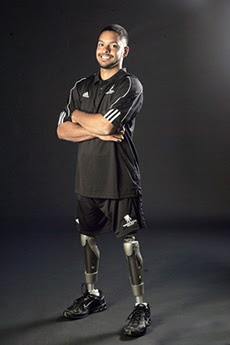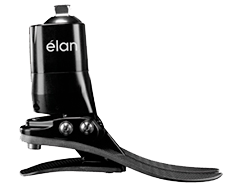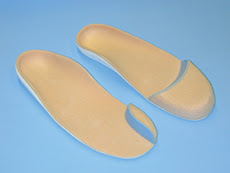People born without an arm or hand, or those who experience an upper limb/extremity amputation, are missing not only a limb, but also a sophisticated tool for daily living.
MICHELANGELO PROSTHETIC HAND
Few parts of the human body are as important and complex as our hands. Thanks to four movable fingers and a thumb that can be separately positioned, the Michelangelo® Prosthetic Hand offers innovative, never-before-seen gripping kinematics giving those with upper extremity limb loss new degrees of freedom and restoring numerous hand functions for the user.
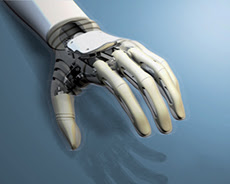
Prosthetic Hand Technology that is a Work of Art
The integrated wrist joint permits flexion, extension and rotation. New grip types are possible thanks to electronic thumb positioning.
- Active thumb positioning with two movement axes
- Wrist joint with flexion, extension and rotation
- More degrees of freedom
Extraordinary Prosthetic Hand Design
 True to its namesake, the Michelangelo Hand offers life-like, sculptural design. The Michelangelo Hand features an extraordinary physiological design. For example, the fingers are made of both hard and soft materials and model bones, joints, muscles and tendons. The new oval wrist adapter also appears much more natural and permits the pronation and supination of the wrist joint. These details, based on nature as a role model, make a major contribution towards the acceptance of the Michelangelo Hand. PVC cosmetic gloves for daily use are available in six different skin tones and complete the realistic look of the Michelangelo Hand.
True to its namesake, the Michelangelo Hand offers life-like, sculptural design. The Michelangelo Hand features an extraordinary physiological design. For example, the fingers are made of both hard and soft materials and model bones, joints, muscles and tendons. The new oval wrist adapter also appears much more natural and permits the pronation and supination of the wrist joint. These details, based on nature as a role model, make a major contribution towards the acceptance of the Michelangelo Hand. PVC cosmetic gloves for daily use are available in six different skin tones and complete the realistic look of the Michelangelo Hand.
PVC cosmetic gloves for daily use are available in six different skin tones and complete the realistic look of the Michelangelo® Prosthetic Hand.
I-DIGITS QUANTUM PROSTHETIC HAND
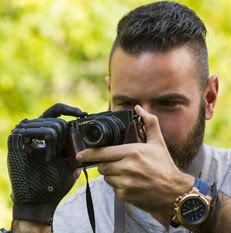 Based on the reliable and industry-leading design of the i-limb™ product range, the i-digits™ quantum hand combines unsurpassed functionality with style. The i-limb quantum hand incorporates Touch Bionic’s patented and ground-breaking i-mo™ technology and is the first partial hand prosthesis that can change grips with a simple gesture.
Based on the reliable and industry-leading design of the i-limb™ product range, the i-digits™ quantum hand combines unsurpassed functionality with style. The i-limb quantum hand incorporates Touch Bionic’s patented and ground-breaking i-mo™ technology and is the first partial hand prosthesis that can change grips with a simple gesture.
I-Digit Quantum Prosthetic Hand Features
Smarter
- i-mo technology – use of simple gestures to change grips
- bluetooth enabled grip chips™ activate pre-set grips in proximity to i-digits
Faster
- adjustable speed boost increases digit speed up to 30%
Stronger
- up to 30% more power when needed
More efficient
- 50% more battery life
i-Digits Quantum Prosthetic Hand is appropriate for most partial hand losses or deficiencies below the wrist. Anywhere from one to five digits and any loss of the palm can be replaced.
I-LIMB QUANTUM PROSTHETIC HAND
Based on the reliable and industry-leading design of the i-limb™ product range, the i-limb™ quantum prosthetic hand combines unsurpassed functionality with style. The i-limb quantum hand incorporates Touch Bionic’s patented and ground-breaking i-mo™ technology and is the first upper limb prosthesis that can change grips with a simple gesture.
Features at a glance
- Smarter – i-mo technology – use of simple gestures to change grips
- Faster – boost digit speed by up to 30%
- Stronger – up to 30% more power when needed
- Smaller – anatomical styling now available in 3 sizes – smaller size hand suitable for women and children
I-LIMB PROSTHETIC HANDS
The i-limb ultra revolution and the i-limb are revolutionay prosthetic hands that that duplicates the function of the human hand. They offer many customizable features, providing wearers with the flexibility to perform a wide range of daily activities with improved control, accuracy, and ease-of-use.
Traditional myoelectric devices offer only one grip pattern which must generate a stronger-than-human grip force at the tip, where the fingers meet, in order to successfully hold heavy or odd-shaped items.
The i-limb hands, with its individually motorized fingers, have the ability to articulate, or wrap around objects, and rotate the thumb, enabling the hand to create many different grips. This allows a patient to grasp objects as a real hand would and perform more complex daily tasks such as typing, dialing the phone, throwing a baseball or shaking hands.
The i-limb Ultra Revolution Prosthetic Hand
Features include:
- Powered rotating prosthetic thumb
- grip chips™ communicate via bluetooth technology for immediate grip access to perform a variety of daily tasks (see video demo below).
- Mobile control app with instant access to up to 36 grip patterns
- With the i-limb ultra revolution, your prosthesis offers more dexterity and moves more like a natural hand. Each finger bends at the natural joints so that it can accurately adapt to fit around the shape of the object you want to grasp.
- Choose from a wide selection of automated grips and gestures to help you complete your daily tasks, such as index point for typing, precision pinch mode for gripping small objects or natural hand position for walking or while at rest.
- Utilizing its pulsing and vari-grip features, the i-limb ultra revolution provides the ability to gradually increase the strength of its grip on an object. This can be very useful in situations where a firmer grasp is required, such as tying shoelaces tightly or holding a heavy bag more securely.
The i-limb Ultra Prosthetic Hand
Features include:
- Vari-grip mode allows variable digit-by-digit grip strength
- Gesture selection allows users to create custom gestures
- Mobile app control provides instant access to 14 programmable grip patterns, allowing flexibility and responsiveness in every day situations
- Three new tripod grips for increased user flexibility
- Auto-grasp feature to prevent objects from slipping
- Hand automatically moves to a natural position after period of inactivity
- Low battery warning audio signal
- Original shipment includes three (3) i-limb skin active covering and four (4) i-limb skin natural coverings
- Power management, extending daily battery usage by 25%
- Dedicated support for prosthetists and therapists
- 12-60 months of touch care Program Coverage
AMPUTATION LEVELS
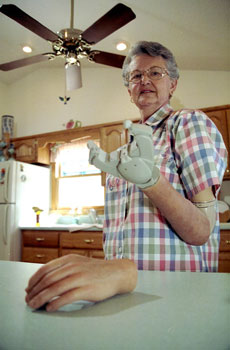 The type of prosthesis you will wear is based largely upon the length of your residual limb.
The type of prosthesis you will wear is based largely upon the length of your residual limb.
Different Types of Amputations
There are several different types of upper extremity amputations that can occur including:
- Fingers or partial hand (transphalangeal or transcarpal)
- Wrist disarticulation (through the wrist joint)
- Below-elbow (transradial)
- Elbow disarticulation (through the elbow joint)
- Above-elbow (transhumeral)
- Bilateral (both sides of the body are affected)
- Shoulder disarticulation (through the shoulder joint)
- Interscapular Thoracic (removal of entire shoulder girdle)
To Wear a Prosthesis or Not to Wear a Prosthesis
Although we would encourage most upper extremity amputees to at least try wearing a prosthesis, some people adapt to their limb difference over time and prefer not to wear one. Our goal is to be sure that you understand all the options available in order to make a thoroughly informed choice for yourself. Even if you have opted not to use a prosthesis in the past, it is always possible to make an appointment with a Innovative Clinic Upper Extremity Specialist and reconsider your options. That said, it is also important to note that in general, the longer a person goes without using an upper extremity prosthesis, the more difficult it can be to learn.
FITTING & CASTING
The fitting process for a prosthesis usually begins when your residual limb is no longer tender or swollen. Typically, this is four to six weeks after surgery. In some cases, immediate postoperative care will be used and a socket or rigid dressing will be placed on the limb during the first week following surgery.
PROSTHETIC OPTIONS
Know Your Options
One option is choosing not to wear a prosthesis. For some people, this is the best choice and the one with which they are most comfortable. There may be limited functional advantage to using a prosthesis and they may prefer to adapt to their limb deficiency. Other reasons may be a negative experience with their first prosthesis or the prospect of revision surgery, which is sometimes necessary for a successful prosthetic fit.
Passive Prosthesis
The passive prosthesis, which is a cosmetic restoration, is another option for upper extremity patients. It is an excellent choice for users who do not require precise hand control or grasp, but still seek a cosmetically pleasing prosthesis.
Conventional or Body-Powered Prosthesis
The conventional or body-powered prosthesis is a choice many upper extremity users make. This prosthesis is suspended from a harness fastened around the person’s shoulder or upper torso. It is controlled by upper body movements that utilize a cable connected to the harness at one end, and to a mechanical hand, hook or elbow at the other end. Many people feel this type of prosthesis grants them a wide range of basic function and control.
Electrically Powered Prosthesis
Another option is the electrically powered prosthesis that utilizes motors to open and close the hand, and can also flex and extend the elbow or rotate the wrist. This option offers many control choices.
Myoelectric Prosthesis
One of the most popular is myoelectric control. The user controls the prosthesis by contracting the muscles in the residual limb, generating EMG signals that activate the motor in the elbow, wrist or hand. Some people find that the myoelectric prosthesis allows a greater range of motion, a more natural appearance, and enhanced work ability. It is also more comfortable since the harness is either smaller or is eliminated completely.
Hybrid Prosthesis
Combining elements of the conventional and the electrically powered prosthesis create another option – the hybrid. A hybrid prosthesis provides the user with the unique ability to operate the elbow and the hand at the same time. This feature can dramatically increase the rehabilitation potential of some individuals.
Finally, the adaptive or activity-specific prosthesis is meant for the individual whose specialized requirements cannot be met by the other options. Various terminal devices can be utilized depending on the specialized activity. For example, custom adaptations can be fabricated for photography, swimming, basketball, baseball, golf, fishing, pool and most other recreational activities.

